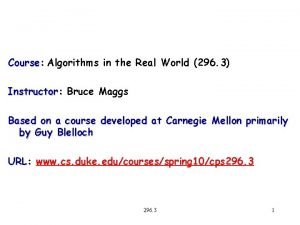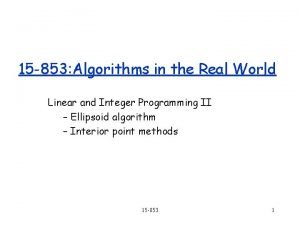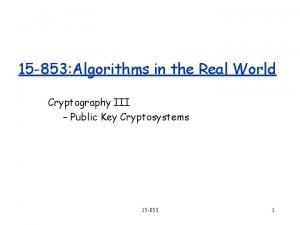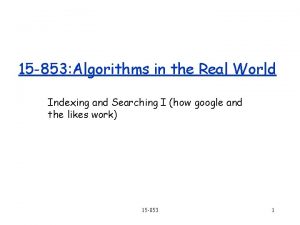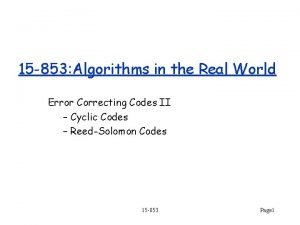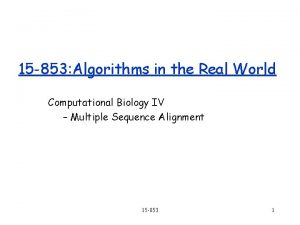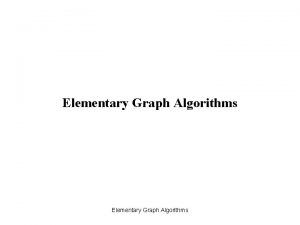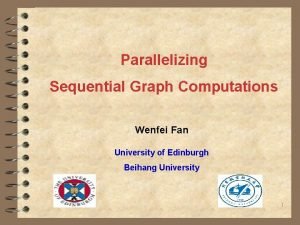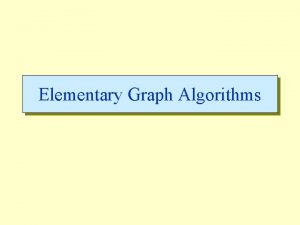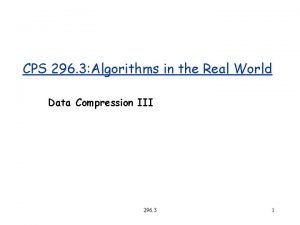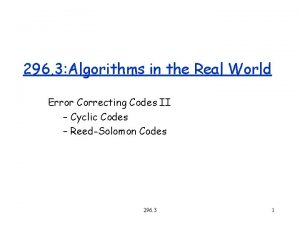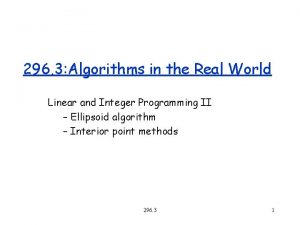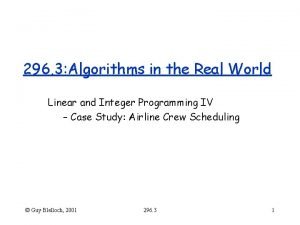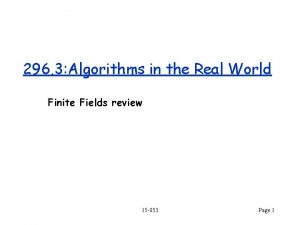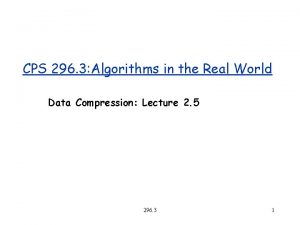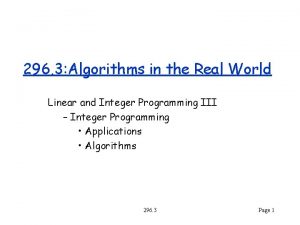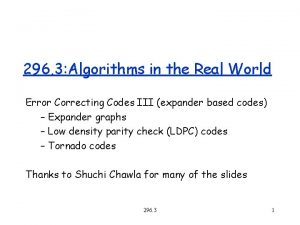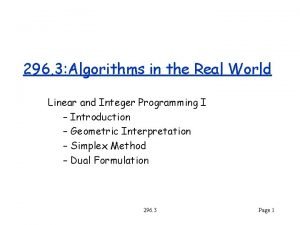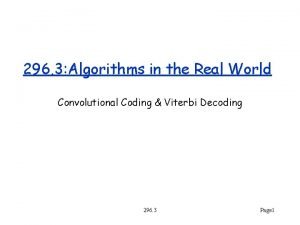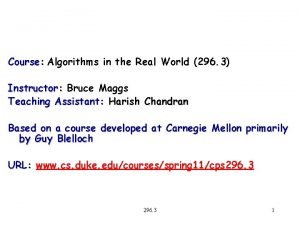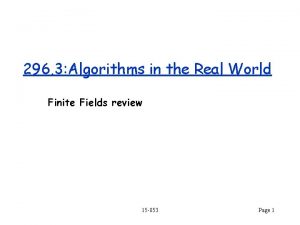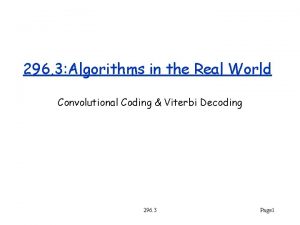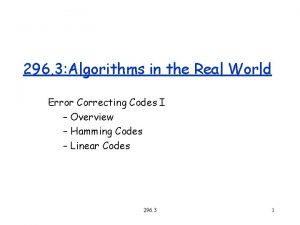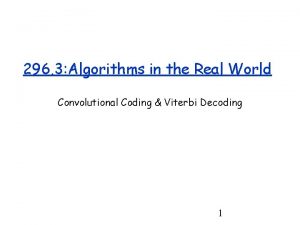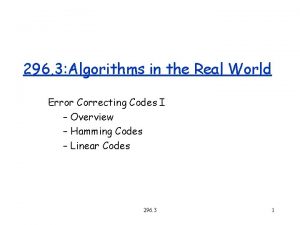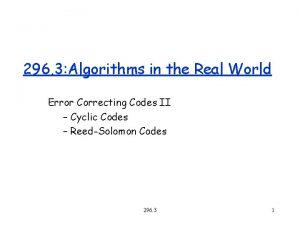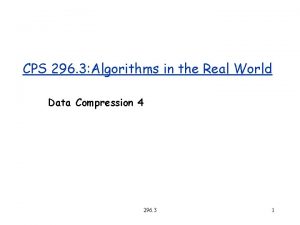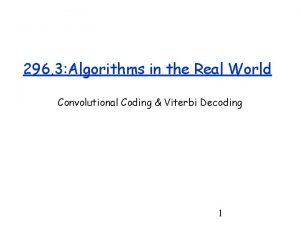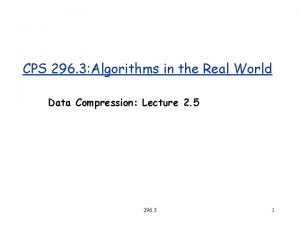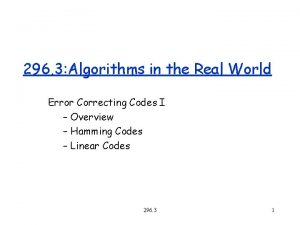296 3 Algorithms in the Real World Graph




























































- Slides: 60

296. 3: Algorithms in the Real World Graph Separators – Introduction – Applications 296. 3 1

Edge Separators An edge separator : a set of edges E’ E which partitions V into V 1 and V 2 2 0 1 3 V 1 Criteria: |V 1|, |V 2| balanced |E’| is small 6 4 5 7 V 2 8 E’ 296. 3 2

Vertex Separators An vertex separator : a set of vertices V’ V which partitions V into V 1 and V 2 Criteria: |V 1|, |V 2| balanced |V’| is small 2 0 V 1 V 2 1 3 6 4 5 7 8 296. 3 3

Compared with Min-cut: as in the mincut, max-flow theorem. Min-cut has no balance criteria. Min-cut typically has a source (s) and sink (t). Min-cut tends to find unbalanced cuts. t V 2 V 1 s E’ 296. 3 4

Other names Sometimes referred to as – graph partitioning (probably more common than “graph separators”) – graph bisectors – graph bifurcators – balanced or normalized graph cuts 296. 3 5

Recursive Separation 296. 3 6

Recursive Separation 0 1 2 3 0 7 3 8 6 1 7 4 8 4 1296. 3 2 1 5 8 7 0 4 4 0 3 6 5 8 8 5 2 5 6 5 2 7 6

What graphs have small separators? Planar graphs: O(n 1/2) vertex separators 2 d meshes, constant genus, excluded minors Almost planar graphs: the Internet, power networks, road networks Circuits need to be laid out without too many crossings Social network graphs: phone-call graphs, link structure of the web, citation graphs, “friends graphs” 3 d-grids and meshes: O(n 2/3) 296. 3 8

What graphs don’t have small separators Hypercubes: O(n) edge separators O(n/(log n)1/2) vertex separators Butterfly networks: O(n/log n) separators Expander graphs: Graphs such that for any U V, s. t. |U| a |V|, |neighbors(U)| b |U|. (a < 1, b > 0) random graphs are expanders, with high probability It is exactly the fact that they don’t have small separators that make these graphs useful. 296. 3 9

Applications of Separators 296. 3 10

Applications of Separators Circuit Layout (from 1960 s) Out of core algorithms VLSI layout Register allocation Solving linear systems Shortest Paths (nested dissection) Graph compression n 3/2 time for planar graphs Graph embeddings Partitioning for parallel algorithms Approximations to NP hard problems TSP, maximum-independent-set Compact Routing and Shortest-paths Clustering and machine learning Machine vision 296. 3 11

Available Software METIS: U. Minnesota PARTY: University of Paderborn CHACO: Sandia national labs JOSTLE: U. Greenwich SCOTCH: U. Bordeaux GNU: Popinet Benchmarks: • Graph Partitioning Archive 296. 3 12

Different Balance Criteria Bisectors: 50/50 Constant fraction cuts: e. g. 1/3, 2/3 edge Trading off cut size for balance (vertex separators): |E’| flux min cut criteria: isoperimetric |E’| number = sparsity min quotient separator: All versions are NP-hard 296. 3 13

Other Variants of Separators k-Partitioning: Might be done with recursive partitioning, but direct solution can give better answers. Weighted: Weights on edges (cut size), vertices (balance) Hypergraphs: Each edge can have more than 2 end points common in VLSI circuits Multiconstraint: Trying to balance different values at the same time. 296. 3 14

Asymptotics If S is a class of graphs closed under the subgraph relation, then Definition: S satisfies an f(n) vertexseparator theorem if there are constants a < 1 and b > 0 so that for every G S there exists a vertex cut set V’ V, with 1. |V’| b f(|G|) cut size 2. |V 1| a |G|, |V 2| a |G| balance Similar definition for edge separators. 296. 3 15

Edge vs. Vertex separators If a class of graphs satisfies an f(n) edge-separator theorem then it satisfies an f(n) vertex-separator. The other way is not true (unless degree is bounded) |E’| = n/2 296. 3 16

Separator Trees 0 1 2 3 0 7 3 8 6 1 7 4 8 4 1296. 3 2 1 5 8 7 0 4 4 0 3 6 5 8 8 5 2 5 6 5 2 17 6

Separator Trees Theorem: For S satisfying an (a, b) f(n) = n 1 -e edgeseparator theorem, we can generate a perfectly balanced separator with size |C| k b f(|G|). Proof: by picture |C| b n 1 -e(1 + a 2 + …) b n 1 -e(1/1 -a) 296. 3 18

Algorithms for Partitioning All are either heuristics or approximations – Kernighan-Lin, Fiduccia-Mattheyses (heuristic) – Planar graph separators (finds O(n 1/2) separators) – Geometric separators (finds O(n(d-1)/d) separators in Rd) – Spectral (finds O(n(d-1)/d) separators in Rd) – Flow/LP-based techniques (give log(n) approximations) – Multilevel recursive bisection (heuristic, currently most practical) 296. 3 19

Kernighan-Lin Heuristic Local heuristic for edge-separators based on “hill climbing”. Will most likely end in a local-minima. Two versions: Original K-L: takes n 2 time per pass Fiduccia-Mattheyses: takes linear time per pass 296. 3 20

High-level description for both Start with an initial cut that partitions the vertices into two equal size sets V 1 and V 2 Want to swap two equal sized sets X A and Y B to reduce the cut size. C A X B Y Note that finding the optimal subsets X and Y solves the optimal separator problem, so it is NP hard. We want some heuristic that might help. 296. 3 21

Some Terminology C(A, B) : the weighted cut between A and B I(v) : the number of edges incident on v that stay within the partition E(v) : the number of edges incident on v that go to the other partition D(v) : E(v) - I(v) D(u, v) : D(u) + D(v) - 2 w(u, v) the gain for swapping u and v 296. 3 A C v B u 22

Kernighan-Lin improvement step KL(G, A 0, B 0) u A 0, v B 0 put (u, v) in a PQ based on D(u, v) for k = 1 to |V|/2 C (u, v) = max(PQ) (Ak, Bk) = (Ak-1, Bk-1) swap (u, v) delete u and v entries from PQ update D on neighbors (and PQ) select Ak, Bk with best Ck A v B u Note that can take backward steps (“gain” D(u, v) can be negative). 296. 3 23

Fiduccia-Mattheyses’s improvement step FM(G, A 0, B 0) u A 0 put u in PQA based on D(u) v B 0 put v in PQB based on D(v) C for k = 1 to |V|/2 u = max(PQA) put u on B side and update D v = max(PQb) put v on A side and update D select Ak, Bk with best Ck 296. 3 A v B u 24

Two examples of KL or FM Consider following graphs with initial cut given in red. 296. 3 25

A Bad Example for KL or FM Consider following graph with initial cut given in red. 2 2 2 1 1 1 2 KL (or FM) will start on one side of the grid (e. g. the blue pair) and flip pairs over moving across the grid until the whole thing is flipped. After one round the graph will look identical? 296. 3 26

Boundary Kernighan-Lin (or FM) Instead of putting all pairs (u, v) in Q (or all u and v in Q for FM), just consider the boundary vertices (i. e. vertices adjacent to a vertex in the other partition). Note that vertices might not originally be boundaries but become boundaries. In practice for reasonable initial cuts this can speed up KL by a large factor, but won’t necessarily find the same solution as KL. 296. 3 27

Performance in Practice In general the algorithms do very well at smoothing a cut that is approximately correct. Works best for graphs with reasonably high degree. Used by most separator packages either 1. to smooth final results 2. to smooth partial results during the algorithm 296. 3 28

Separators Outline Introduction: Algorithms: – Kernighan Lin – BFS and PFS – Multilevel – Spectral 296. 3 29

Breadth-First Search Separators 1 2 3 4 5 Run BFS and as soon as you have included half the vertices return that as the partition. Won’t necessarily be 50/50, but can arbitrarily split vertices in middle level. 6 Used as substep in Lipton. Tarjan planar separators. In practiced does not work well on its own. 296. 3 30

Picking the Start Vertex 1. Try a few random starts and select best partition found 2. Start at an “extreme” point. Do an initial DFS starting at any point and select a vertex from the last level to start with. 3. If multiple extreme points, try a few of them. 296. 3 31

Priority-First Search Separators 2 3 4 1 5 9 Prioritize the vertices based on their gain (as defined in KL) with the current set. Search until you have half the vertices. 10 11 6 7 8 296. 3 32

Multilevel Graph Partitioning Suggested by many researchers around the same time (early 1990 s). Packages that use it: – METIS – Jostle – TSL (GNU) – Chaco Best packages in practice (for now), but not yet properly analyzed in terms of theory. Mostly applied to edge separators. 296. 3 33

High-Level Algorithm Outline Multilevel. Partition(G) If G is small, do something brute force Else Coarsen the graph into G’ (Coarsen) A’, B’ = Multilevel. Partition(G’) Expand graph back to G and project the partitions A’ and B’ onto A and B Refine the partition A, B and return result Many choices on how to do underlined parts 296. 3 34

MGP as Bubble Diagram G Coarsen Expand, Project and Refine “Brute Force” 296. 3 35

How to Coarsen Goal is to pick a sample G’ such that when we find its partition it will help us find the partition of G. Possibilities? 296. 3 36

Random Sampling Pick a random subset of the vertices. Remove the unchosen vertices and their incident edges 296. 3 37

Random Sampling Pick a random subset of the vertices. Remove the unchosen vertices and their incident edges Graph falls apart if it is not dense enough. 296. 3 38

Maximal Matchings A maximal matching is a pairing of neighbors so that no unpaired vertex can be paired with an unpaired neighbor. The idea is to contract pairs into a single vertex. 296. 3 39

A Maximal Matching Can be found in linear time greedily. 296. 3 40

A side note Compared to a maximum matching: a pairing such that the number of covered nodes is maximum 296. 3 41

Coarsening 296. 3 42

Collapsing and Weights 1 2 2 1 Why care about weights? 296. 3 New vertices become weighted by sum of weights of their pair. New edges (u, v) become weighted by sum of weights of multiple edges (u, v) We therefore have to solve the weighted problem. 43

Heuristics for finding the Matching Random : randomly select edges. Prioritized: the edges are prioritized by weight. Visit vertices in random order, but pick highest priority edge first. – Heaviest first: Why might this be a good heuristic? – Lightest first: Why might this be a good heuristic? Highly connected components: (or heavy clique matching). Looks not only at two vertices but the connectivity of their own structure. 296. 3 44

Finding the Cut on the Coarsened Graph 296. 3 45

Exanding and “Projecting” 296. 3 46

Refining e. g. by using Kernighan-Lin 296. 3 47

After Refinement 296. 3 48

METIS Coarsening: “Heavy Edge” maximal matching. Base case: Priority-first search based on gain. Randomly select 4 starting points and pick best cut. Smoothing: Boundary Kernighan-Lin Has many other options. e. g. , Multiway separators. 296. 3 49

Separators Outline Introduction: Algorithms: – Kernighan Lin – BFS and PFS – Multilevel – Spectral 296. 3 50

Spectral Separators Based on the second eigenvector of the “Laplacian” matrix for the graph. Let A be the adjacency matrix for G. Let D be a diagonal matrix with degree of each vertex. The Laplacian matrix is defined as L = D-A 296. 3 51

Laplacian Matrix: Example 1 2 5 3 4 Note that each row sums to 0. 296. 3 52

Fiedler Vectors Eigenvalues l 1 l 2 l 3 . . . ln, real, non-negative. Find eigenvector corresponding to the second smallest eigenvalue: L x 2 = l 2 x 2 This is called the Fiedler vector. What is true about the first eigenvector? 296. 3 53

Modes of Vibration x 2 (Picture from Jim Demmel’s CS 267 course at Berkeley. ) 296. 3 54

Fiedler Vector: Example 1 2 5 3 4 Note that each row sums to 0. If graph is not connected, what is the second eigenvalue? 296. 3 55

Finding the Separator Sort Fiedler vector by value, and split in half. 1 2 5 3 4 sorted vertices: [3, 1, 4, 5, 2] 296. 3 56

Power Method Iterative method for finding first few eigenvectors. Every vector is a linear combination of its eigenvectors e 1 , e 2 , … Consider: p 0 = a 1 e 1 + a 2 e 2 + … Iterating pi+1 = Api until it settles will give the principal eigenvector (largest magnitude eigenvalue) since p i = l 1 i a 1 e 1 + l 2 i a 2 e 2 + … (Assuming all ai are about the same magnitude) The more spread in first two eigenvalues, the faster it will settle (related to the rapid mixing of expander graphs) 296. 3 57

The second eigenvector Assuming we have the principal eigenvector, after each iteration remove the component that is aligned with the principal eigenvector. ni = A pi-1 pi = ni – (e 1 ni)e 1 (assuming e 1 is normalized) Now p i = l 2 i a 2 e 2 + l 3 i a 3 e 3 + … Can use random vector for initial p 0 296. 3 58

Power method for Laplacian To apply the power method we have to shift the eigenvalues, since we are interested in eigenvector with eigenvalue closest to zero. How do we shift eigenvalues by a constant amount? Lanczos’ algorithm is faster in practice if starting from scratch, but if you have an approximate solution, the power method works very well. 296. 3 59

Multilevel Spectral Multilevel. Fiedler(G) If G is small, do something brute force Else Coarsen the graph into G’ e’ 2 = Multilevel. Fiedler(G’) Expand graph back to G and project e’ 2 onto e 2 Refine e 2 using power method and return To project, you can just copy the values in location i of e’ 2 into both vertices i expands into. This idea is used by Chaco. 296. 3 60
 Algorithms in the real world
Algorithms in the real world 15-853 algorithms in the real world
15-853 algorithms in the real world Real world cryptography
Real world cryptography 15-853 algorithms in the real world
15-853 algorithms in the real world 15-853 algorithms in the real world
15-853 algorithms in the real world 15-853 algorithms in the real world
15-853 algorithms in the real world Rational functions in the real world
Rational functions in the real world Topological sort演算法
Topological sort演算法 Incrementalizing graph algorithms
Incrementalizing graph algorithms Elementary graph algorithms
Elementary graph algorithms Undirected graph algorithms
Undirected graph algorithms How is factoring polynomials used in real life
How is factoring polynomials used in real life Real world vs digital world
Real world vs digital world Allegory of the cave examples in real life
Allegory of the cave examples in real life Wac 296 155
Wac 296 155 Wac 296-800-160
Wac 296-800-160 Wac 296-305
Wac 296-305 Nnpj-296
Nnpj-296 Sos mihai bravu 296
Sos mihai bravu 296 Wac 296-305
Wac 296-305 E 296
E 296 When placing solid web members for beams/columns
When placing solid web members for beams/columns Wac 296-307
Wac 296-307 Cs 296
Cs 296 Hát kết hợp bộ gõ cơ thể
Hát kết hợp bộ gõ cơ thể Frameset trong html5
Frameset trong html5 Bổ thể
Bổ thể Tỉ lệ cơ thể trẻ em
Tỉ lệ cơ thể trẻ em Voi kéo gỗ như thế nào
Voi kéo gỗ như thế nào Thang điểm glasgow
Thang điểm glasgow Chúa yêu trần thế
Chúa yêu trần thế Các môn thể thao bắt đầu bằng tiếng đua
Các môn thể thao bắt đầu bằng tiếng đua Thế nào là hệ số cao nhất
Thế nào là hệ số cao nhất Các châu lục và đại dương trên thế giới
Các châu lục và đại dương trên thế giới Công của trọng lực
Công của trọng lực Trời xanh đây là của chúng ta thể thơ
Trời xanh đây là của chúng ta thể thơ Mật thư tọa độ 5x5
Mật thư tọa độ 5x5 101012 bằng
101012 bằng độ dài liên kết
độ dài liên kết Các châu lục và đại dương trên thế giới
Các châu lục và đại dương trên thế giới Thơ thất ngôn tứ tuyệt đường luật
Thơ thất ngôn tứ tuyệt đường luật Quá trình desamine hóa có thể tạo ra
Quá trình desamine hóa có thể tạo ra Một số thể thơ truyền thống
Một số thể thơ truyền thống Cái miệng nó xinh thế chỉ nói điều hay thôi
Cái miệng nó xinh thế chỉ nói điều hay thôi Vẽ hình chiếu vuông góc của vật thể sau
Vẽ hình chiếu vuông góc của vật thể sau Nguyên nhân của sự mỏi cơ sinh 8
Nguyên nhân của sự mỏi cơ sinh 8 đặc điểm cơ thể của người tối cổ
đặc điểm cơ thể của người tối cổ Thứ tự các dấu thăng giáng ở hóa biểu
Thứ tự các dấu thăng giáng ở hóa biểu Vẽ hình chiếu đứng bằng cạnh của vật thể
Vẽ hình chiếu đứng bằng cạnh của vật thể Tia chieu sa te
Tia chieu sa te Thẻ vin
Thẻ vin đại từ thay thế
đại từ thay thế điện thế nghỉ
điện thế nghỉ Tư thế ngồi viết
Tư thế ngồi viết Diễn thế sinh thái là
Diễn thế sinh thái là Các loại đột biến cấu trúc nhiễm sắc thể
Các loại đột biến cấu trúc nhiễm sắc thể Bảng số nguyên tố lớn hơn 1000
Bảng số nguyên tố lớn hơn 1000 Tư thế ngồi viết
Tư thế ngồi viết Lời thề hippocrates
Lời thề hippocrates Thiếu nhi thế giới liên hoan
Thiếu nhi thế giới liên hoan ưu thế lai là gì
ưu thế lai là gì
